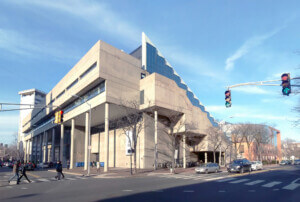The story goes like this: In 1949 an engineer named A.K. Chahroudi commissioned Frank Lloyd Wright to design a home on Petra Island in Lake Mahopac, New York, which Chahroudi owned. But the $50,000 price tag on the 5,000 square foot house was more than Chahroudi could afford, so Wright designed him a smaller, more affordable cottage elsewhere on the island.
Fast forward to 1996 when Joseph Massaro, a sheet metal contractor, bought the island for $700,000, a sale that also included Wright’s original yet unfinished plans. Though he says he only intended to spruce up the existing cottage and not build anything new, one can hardly fault Massaro for wanting to follow through on a home Wright once said would eclipse Falling Water. In 2000 Massaro sold his business and hired Thomas A. Heinz, an architect and Wright historian, to complete and update the design, a move that incensed the Frank Lloyd Wright Foundation, who promptly sued him, stating he couldn’t claim the house was a true Wright, but was only “inspired” by him.
Massaro was able to complete the house in 2004, fending off lawsuits by stating his intent not to sell. Now, however, he’s ruffled the Wright Foundation’s feathers once again by putting the house on the market for $19.9 million, 11-acre island included. Even though the house is not recognized by the Foundation, that hasn’t stopped Massaro from listing it as a true Wright. In a statement to the Los Angeles Times he said, “You hear these purists that talk about how no unbuilt Frank Lloyd Wright house should ever be built because Frank Lloyd Wright isn’t here anymore. And then you take a look at this masterpiece of his—I’m sure Frank would rather have it built than not built at all.”
That may be true, but those purists are an outspoken bunch, citing four details in Massaro’s house that Wright would never have approved of had he been alive to see its construction. First, the decorative “rubblestone,” a Wright trademark, is not flush in Massaro’s home, but protrude from the wall—a major Wright no-no. Second, the home’s 26 skylights are domed, not flat, a choice Massaro apparently made citing flat skylights’ propensity to leak (sealants, anyone?). Third, an exterior stairway that appears in several of Wright’s original drawings was nixed by Massaro, as it would have landed in three feet of water due to the island’s changed coastline. Lastly, Wrightians claim that the copper fascia are too shallow, a seemingly petty point of contention, but as Wright house owner Rich Herber pointed out, “It’s the small details we’ll never know about.”
To be fair, Massaro seems to have tried to stay as true to Wright’s original intentions as possible. When the late Walter Cronkite, who knew Wright personally, visited the property he said, “I feel Frank in this house.” Whether or not it’s technically authentic and officially condoned by the Foundation, or the result of a Wright/Heinz collaboration, the world is probably a better and more beautiful place for the existence of the Massaro House, which interested buyers can arrange to visit to through Ahahlife.com.
All images courtesy Ahahlife.










